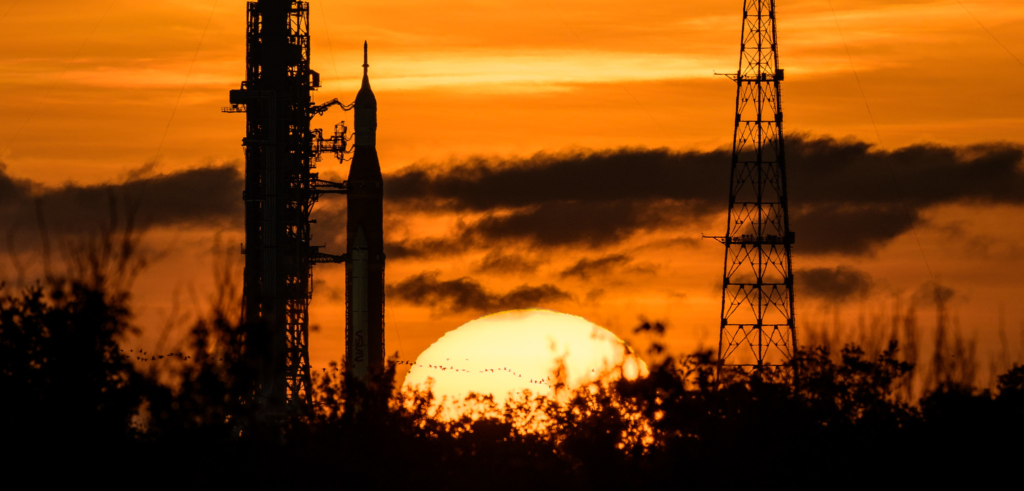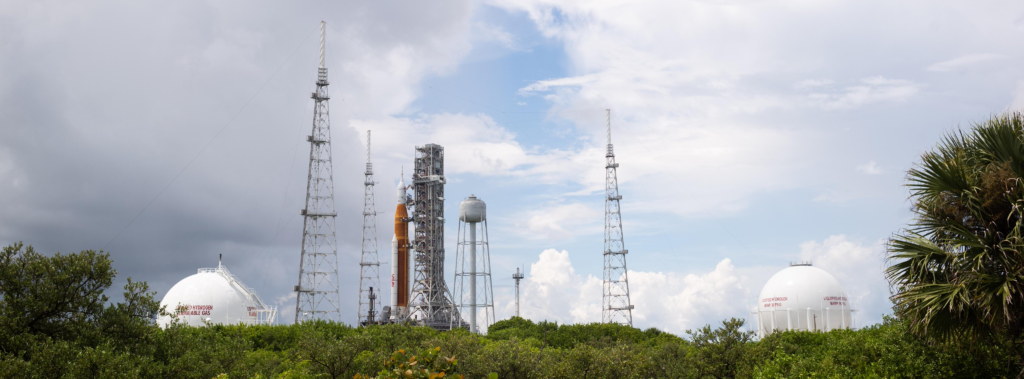
Tomorrow The Space Launch System Has A Second Launch Attempt
The Space Launch System has had quite a busy schedule over the past few months. After an eventful wet dress rehearsal and continued testing, the launch vehicle finally made it to the first launch day only a few days ago. Unfortunately, due to a few different problems, the first launch attempt was scrubbed. This being said, tomorrow NASA and SLS will have a second chance to lift off and begin a journey to the Moon.
Specifically, tomorrow, September 3rd, a two hour launch window will open at 2:17 p.m. EDT. As of right now, looking at different factors such as the rocket’s condition, weather, and more, the agency is confident the Space Launch System will take off for the first time on Saturday. However, only days ago a host of issues arose that brought the launch to a halt.
These issues included a liquid hydrogen leak at the mating interface with the core stage, and most notably an issue with one of the four RS-25 engines on the core stage. Here I will go more in-depth into the mission plan for tomorrow, what the agency has done to address these issues, and more.
The Plan For Tomorrow

Since the first launch attempt only a few days ago, NASA has been working in overdrive in preparation for tomorrow. This prep began only hours after the first attempt was scrubbed. Here, engineers evaluated data gathered during the Artemis I launch attempt Monday, Aug. 29, when teams could not get the rocket’s engines to the proper temperature range required to start the engines at liftoff, and ran out of time in the two-hour launch window to continue. The Space Launch System’s four RS-25 engines must be thermally conditioned before super cold propellant begins flowing through them for liftoff. Launch controllers condition them by increasing the pressure on the core stage liquid hydrogen tank to route, or “bleed” as it is often called, a portion of the approximately minus 423 F liquid hydrogen to the engines. Soon after the scrub, managers suspected the issue, seen on engine 3, was unlikely to be the result of a problem with the engine itself.
In addition, during the countdown, launch controllers worked through several additional issues, including storms in the area that delayed the start of propellant loading operations, a leak at the quick disconnect on the 8-inch line used to fill and drain core stage liquid hydrogen, and a hydrogen leak from a valve used to vent the propellant from the core stage intertank. This leads us to the 30th when NASA began setting specific dates and continuing to work on various issues. Specifically, NASA decided to target Saturday, Sept. 3 at 2:17 p.m. EDT, the beginning of a two-hour window, for the launch of Artemis I, the first integrated test of NASA’s Orion spacecraft, Space Launch System (SLS) rocket, and the ground systems at the agency’s Kennedy Space Center in Florida.
Mission managers met Tuesday to discuss data and develop a forward plan to address issues that arose during an Aug. 29 launch attempt for the flight test. As partially mentioned prior, during that launch attempt, teams were not able to chill down the four RS-25 engines to approximately minus 420 degrees F, with engine 3 showing higher temperatures than the other engines. Teams also saw a hydrogen leak on a component of the tail service mast umbilical quick disconnect, called the purge can, and managed the leak by manually adjusting propellant flow rates. Over the next few days, teams planned to modify and practice propellant loading procedures to follow a procedure similar to what was successfully performed during the Green Run at NASA’s Stennis Space Center in Mississippi. The updated procedures would perform the chill down test of the engines, also called the kick start bleed test, about 30 to 45 minutes earlier in the countdown during the liquid hydrogen fast fill liquid phase for the core stage.
Teams also worked to configure platforms at Launch Pad 39B to enable engineers access to the purge can on the tail service mast umbilical. Once access is established, technicians will perform assessments and torque connection points where necessary. In terms of the weather, Meteorologists with the U.S. Space Force predict favorable weather conditions for Saturday. While rain showers are expected, they are predicted to be sporadic during the launch window.
The next updates came on the 31st as NASA continued its preparations. Meteorologists predicted a 60% chance of favorable weather conditions for an Artemis I launch attempt during the two-hour window. On Wednesday, engineers worked to implement plans approved at the day prior’s mission management team meeting to address issues that arose during the first launch attempt. The agency also planned that the countdown for launch would be scheduled to resume Saturday at 4:37 a.m., at the L-9 hour, 40 minutes planned hold in the countdown where managers receive a weather briefing and conduct a poll on whether to proceed with propellant loading operations. Launch controllers do not need to begin the initial 46 hour, 10 minute countdown again because many of the configurations needed for launch are already in place.
All these updates finally lead to the most recent news which came yesterday, September 1st. Here, the countdown to launch had officially resumed, and the Artemis I mission management team met that afternoon to review the status of the operations and have given a “go” for a Sept. 3 launch attempt of the Space Launch System rocket and Orion spacecraft. In the time since the previous launch attempt on Monday, teams have updated procedures, practiced operations, and refined timelines. In addition, over the last day, teams worked to fix a leak on the tail service mast umbilical by replacing a flex-hose and a loose pressure sensor line, as the likely source of the leak. Teams also retorqued, or tightened, the bolts surrounding that enclosure to ensure a tight seal when introducing the super-cooled propellants through those lines. While there was no leak detected at ambient temperatures, teams will continue to monitor during tanking operations. Finally, just hours ago NASA tweeted saying, “The countdown is underway for a September 3 launch of #Artemis I! Follow us for the latest updates.” This brings us up to date on the preparation for Artemis I and tomorrow’s launch attempt.
What Went Wrong?

While just prior I pointed out some of the issues NASA ran into and what they were doing to fix them, I want to go more in-depth into exactly what went wrong and the chances of it happening again tomorrow. The first main issue I want to highlight has to do with one of SLS’s main engines, specifically engine 3. During the first launch attempt, while liquid oxygen was loading into the interim cryogenic propulsion stage and core stage tanks continued to be replenished with propellants, engineers began troubleshooting an issue conditioning one of the RS-25 engines (engine 3) on the bottom of the core stage. Launch controllers condition the engines by increasing pressure on the core stage tanks to bleed some of the cryogenic propellant into the engines to get them to the proper temperature range to start them. On the 29th, Engine 3 was not properly being conditioned through the bleed process. This led to the specific engine being at a higher temperature than the other 3 main RS-25 engines. The goal is to chill the engines to around minus 420 degrees Fahrenheit. NASA’s main fix for this issue on tomorrow’s attempt will be to begin the engine chilling operation around 30 to 45 minutes earlier in the countdown during the liquid hydrogen fast fill liquid phase for the core stage. This will follow a procedure just like what was successfully performed during the Green Run.
The other main issue had to do with the tail service mast umbilical. They provide liquid oxygen and liquid hydrogen fluid lines and electrical cable connections to the SLS core stage engine section to support propellant handling during prelaunch operations. During the first launch attempt, a leak was identified at one of the umbilicals. NASA stated they likely fixed the problem after replacing a flex-hose and a loose pressure sensor line. Teams also retorqued, or tightened, the bolts surrounding that enclosure to ensure a tight seal when introducing the super-cooled propellants through those lines. Lastly, on the 29th, teams also assessed what appeared to be a crack in the thermal protection system material on one of the flanges on the core stage. The flanges are connection joints that function like a seam on a shirt, and are affixed at the top and bottom of the intertank so the two tanks can be attached to it. It’s unclear exactly what came of this observation and its importance. Despite these various issues, tomorrow NASA is going to try again.
Conclusion
Only a few days ago NASA attempted to launch SLS for the first time apart of Artemis I. Unfortunately, this attempt ran into a few different problems and NASA decided to scrub the launch. Now the agency is set to try again tomorrow on September 3rd. We will have to wait and see how it progresses and the impact it has on the space industry.
